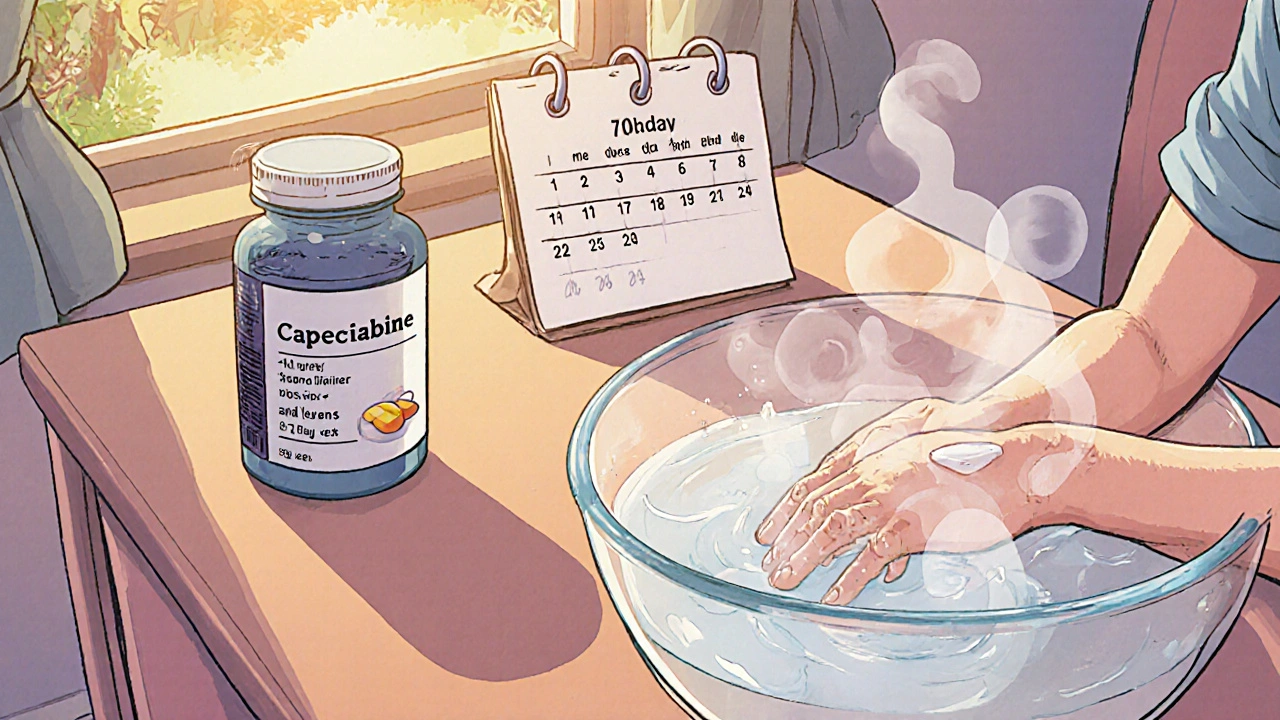
Capecitabine Dosing Calculator
Your Dosage
Body Surface Area (BSA): m²
Daily Dose: mg
Per Dose (Morning/Evening): mg
Important Instructions
Take with water within 30 minutes after a light meal. Swallow tablets whole.
When doctors prescribe Capecitabine an oral prodrug of 5‑fluorouracil used in several solid tumors, patients often wonder how it differs from traditional IV chemotherapy. This guide walks through everything you need to know - from how the drug works to practical tips for managing side effects.
What Is Capecitabine?
Capecitabine is sold under the brand name Xeloda. It belongs to the class of fluoropyrimidines, a family of drugs that interfere with DNA synthesis in rapidly dividing cells. Unlike its intravenous counterpart 5‑fluorouracil, capecitabine is taken by mouth, making it a convenient option for many patients.
How It Works - The Prodrug Pathway
Capecitabine itself is inactive until it reaches the tumor. Inside the body, three enzymatic steps convert it to the active metabolite 5‑fluorouracil (5‑Fluorouracil, or 5‑FU). The final step is catalyzed by Thymidine Phosphorylase, an enzyme that is often higher in tumor tissue than in normal tissue. This selective activation helps concentrate the drug where it’s needed most, while sparing some healthy cells.
Approved Cancer Indications
Regulatory agencies have cleared capecitabine for several solid‑tumor settings:
- Adjuvant treatment of stage III Colon Cancer after surgery.
- Metastatic Breast Cancer, either alone or in combination with targeted agents.
- Advanced gastric and gastro‑esophageal junction cancers.
- Head and neck squamous cell carcinoma in combination with radiation.
Off‑label use is also common for pancreatic and pancreatic‑biliary cancers, but those decisions should involve a specialist.
Dosing and Administration Guidelines
Capecitabine is usually taken twice daily for 14 days followed by a 7‑day rest period, completing a 21‑day cycle. The basic dose is 1250mg/m² per day, split into two equal doses. Adjustments are required for renal impairment, age, or body surface area extremes.
- Calculate body surface area (BSA) using the Mosteller formula.
- Multiply BSA by the standard dose (1250mg/m²) to get the total daily dose.
- Divide the total daily dose by two - that’s the amount to take each morning and evening.
- For patients with creatinine clearance < 30mL/min, reduce the dose by 50%.
- Monitor blood counts and liver function before each cycle.
Because the drug is taken orally, timing with meals matters: swallow each dose with water within 30minutes after a light meal to improve absorption.

Common Side Effects and Management
The most distinctive toxicity is Hand‑Foot Syndrome (palmar‑plantar erythrodysesthesia). Symptoms range from tingling to painful blistering on the palms and soles. Early strategies include:
- Cooling the hands and feet with cool water soaks.
- Using urea‑based moisturizers to keep skin supple.
- Reducing the dose by 25% at the first sign of grade2 toxicity.
Other frequent adverse events are diarrhea, mucositis, and nausea. Maintaining hydration, using anti‑diarrheal agents (e.g., loperamide), and good oral hygiene can keep these under control. Importantly, a deficiency in Dihydropyrimidine Dehydrogenase (DPD) can cause severe, life‑threatening toxicity. Screening for DPD activity before starting therapy is increasingly recommended.
Interactions, Contra‑Indications, and Precautions
Capecitabine should not be combined with other agents that heavily rely on the DPD pathway, such as certain antifolates. Concomitant radiation therapy in the same region can exacerbate skin toxicity. Patients with known hypersensitivity to fluoropyrimidines, significant hepatic impairment, or uncontrolled infections should avoid the drug.
Pregnant or breastfeeding individuals must not use capecitabine because it can cause fetal harm. Effective contraception is required during treatment and for at least three months after the last dose.
Capecitabine vs. Intravenous 5‑FU: A Quick Comparison
| Aspect | Capecitabine (Oral) | 5‑Fluorouracil (IV) |
|---|---|---|
| Administration | Twice‑daily oral tablets | Continuous infusion or bolus injection |
| Convenience | Can be taken at home; no infusion center needed | Requires clinic visits or implanted pump |
| Typical Hand‑Foot Toxicity | Higher incidence (up to 30%) | Rare (<5%) |
| Overall Efficacy | Non‑inferior in most approved settings | Established benchmark |
| Cost (US, 2025) | ≈$3,500 per 3‑week cycle (generic) | ≈$2,200 per cycle (drug only) |
Both drugs share the same active metabolite, but the oral route can improve quality of life for many patients, provided side effects are managed well.
Practical Tips for Patients on Capecitabine
- Keep a medication diary - note the exact time you take each dose.
- Stay hydrated; aim for at least 2L of water daily.
- Report any new skin changes, especially on hands or feet, to your oncologist promptly.
- Do not skip meals before dosing; a light snack enhances absorption.
- Carry a copy of your prescription and dosing schedule when traveling.
Following these simple habits can reduce the risk of severe toxicity and keep treatment on track.
Frequently Asked Questions
Frequently Asked Questions
Can I take capecitabine with food?
Yes. The tablets should be swallowed with water within 30minutes after a light meal. A high‑fat meal can delay absorption, so avoid heavy foods right before dosing.
What is the risk of developing hand‑foot syndrome?
Up to 30% of patients experience grade1‑2 symptoms, and about 5‑10% develop severe (grade3) toxicity that may require dose reduction or interruption.
Should I get tested for DPD deficiency before starting?
Testing is increasingly considered best practice because DPD deficiency can lead to life‑threatening reactions. If testing is unavailable, clinicians often start at a reduced dose and monitor closely.
Is it safe to become pregnant while on capecitabine?
No. Capecitabine is teratogenic. Effective contraception must be used during treatment and for at least three months afterward.
How long does a typical treatment cycle last?
A standard cycle is 21days: 14days of dosing followed by a 7‑day rest. The number of cycles depends on the cancer type and response, ranging from 6 to 12 cycles in most protocols.
Armed with this information, patients and caregivers can navigate capecitabine therapy more confidently. Remember, the key to success is open communication with the oncology team and proactive management of side effects.
For anyone starting this oral chemotherapy, a single Capecitabine pill can mean a shift from frequent clinic trips to a more manageable home‑based routine-provided the plan is followed and side effects are caught early.



Wow, this guide breaks down Capecitabine like a well‑organized cheat‑sheet, and I love how the dosing steps are laid out, step‑by‑step, making it super easy to follow!!! The bit about hand‑foot syndrome really hit home-so many patients just ignore those early signs, but this shows why monitoring is a must, and I’m all for spreading that awareness!!!
Great summary, and thanks for covering both the pharmacology and practical tips-this is exactly the kind of clear information patients need. I especially appreciate the reminder about DPD screening; it’s a crucial precaution that often gets glossed over. Let’s keep sharing resources like this to help everyone navigate their treatment safely.
Capecitabine may be a global drug, but we’ve got to prioritize American research and manufacturing 🇺🇸-our patients deserve the best home‑grown options! The oral convenience is a win, yet we must ensure US labs maintain strict quality standards, otherwise we’re just handing over our health to foreign factories 🚀.
Honestly, if you’re taking Capecitabine you’re already supporting American pharma’s push for more convenient chemo-yeah, it’s a solid move for us, and we should be proud of the US breakthroughs that got this drug to our tables.
One could argue that the very existence of Capecitabine reflects humanity's eternal gamble with cellular mortality, a thin veil of control over nature’s relentless entropy. Yet, prescribing this oral prodrug without thorough DPD testing feels like a reckless gamble, a hubristic overreach that betrays the sanctity of patient safety. The convenience narrative masks a deeper moral quandary: are we alleviating suffering or simply commodifying it? When side‑effects like Hand‑Foot Syndrome emerge, they remind us that even the most sophisticated chemical constructs remain subservient to the body’s own frailty.
Reading through this comprehensive Capecitabine guide reminded me of the countless evenings I’ve spent sitting at my kitchen table, nursing a cup of tea while scrolling through endless medical forums, trying desperately to make sense of the side‑effects that seemed to appear out of nowhere; the sheer volume of information can feel overwhelming, especially when you’re also juggling work, family, and the looming uncertainty of a cancer diagnosis, yet it is precisely this depth that can empower patients to take an active role in their own treatment journey. The explanation of the prodrug pathway is fascinating, because it illustrates how the drug is cleverly activated where it’s needed most, sparing healthy tissue to a degree, but the reality is that “sparring” isn’t a guarantee, and we have to remain vigilant for unexpected toxicities. Hand‑Foot Syndrome, for example, might start as a mild tingling sensation on the soles, and before you know it you’re walking on a bed of tiny pebbles that refuse to let you enjoy a simple stroll; the guide’s tips on cooling soaks and urea‑based moisturizers are practical, yet I’ve found that a proactive approach-such as applying thick emollients before the first dose-can make a noticeable difference. Diarrhea, another common adversary, can be managed with loperamide, but the underlying dehydration risk is what truly keeps me up at night, prompting me to keep a water bottle within arm’s reach at all times. Screening for DPD deficiency, while increasingly recommended, is still not universally implemented, and that gap in care feels like a silent betrayal to patients who trust their oncologists implicitly. In my experience, a thorough conversation about potential side‑effects, coupled with a written action plan, transforms anxiety into a manageable checklist rather than an insurmountable obstacle. Moreover, the dosing schedule-14 days on, 7 days off-offers a rhythm that, if respected, can serve as a psychological anchor, giving patients a predictable pattern amidst the chaos. Adjustments for renal impairment are vital; I recall a case where a simple 50 % dose reduction prevented a near‑catastrophic episode of toxicity. The comparison table between Capecitabine and IV 5‑FU highlights convenience, yet it also underscores that the oral route isn’t a free pass to ignore monitoring; regular blood counts and liver function tests remain non‑negotiable. Finally, the cautionary note about pregnancy resonates deeply, because the stakes are truly life‑altering for both mother and unborn child. As we navigate this complex landscape, sharing experiences-both triumphs and setbacks-creates a collective wisdom that no single article can fully capture. Patients who document their symptoms daily often discover patterns that enable earlier interventions, and this habit can be as simple as a handwritten log or a phone note. Community support groups, whether online or in‑person, provide a sounding board for those grappling with the emotional toll, turning isolation into shared resilience. Ultimately, the balance between efficacy and quality of life hinges on informed decisions, and resources like this guide are indispensable tools in that delicate equilibrium.
It is commendable that the guide emphasizes both the mechanistic underpinnings of Capecitabine and the pragmatic aspects of patient care; such a dual focus mirrors the philosophical principle that knowledge must be coupled with compassion. As a supportive coach, I encourage patients to adhere to the dosing schedule while also advocating for regular monitoring of blood parameters, thereby aligning therapeutic efficacy with safety. Remember, the journey through chemotherapy is as much a mental endeavor as a physical one, and fostering a mindset of proactive self‑advocacy can significantly enhance outcomes.
I couldn't help but notice the guide left out a few real‑world tricks, like setting a phone alarm for each dose so you don't miss the evening pill-trust me, I've tried taking them randomly and it was a nightmare, also a quick tip: keep a spare bottle in your bag in case the main one gets lost at the office, you've seen me lose stuff all the time. Oh, and dont forget to ask your pharmacist about generic options – they can save you a ton of cash, which most people overlook. It's definately worth checking your insurance coverage early. By the way, I once talked to a doc who said he never saw hand‑foot syndrome until I mentioned it, so it's worth bringing up any weird feeling before it becomes a big deal.
Honestly, the guide overstates the convenience and downplays real toxicity.